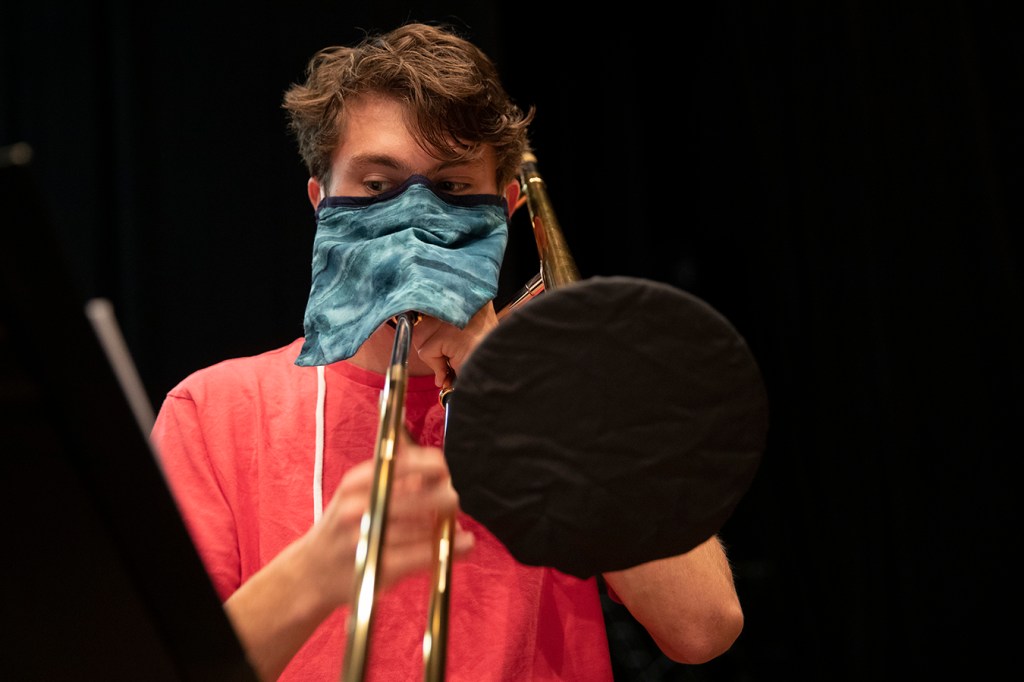Trombonist Jerrell Charleston loves the give-and-take of jazz, the creativity of riffing off other musicians. But as he looked toward his sophomore year at Indiana University, he feared that steps to avoid sharing the coronavirus would also keep students from sharing songs.
“Me and a lot of other cats were seriously considering taking a year off and practicing at home,” lamented the 19-year-old jazz studies major from Gary, Indiana.
His worries evaporated when he arrived on campus and discovered that music professor Tom Walsh had invented a special mask with a hole and a protective flap to allow musicians to play while masked.
Students also got masks for the ends of their wind instruments, known as bell covers, allowing them to jam in person, albeit 6 feet apart.
“It’s amazing to play together,” Charleston said. “Music has always been my safe space. It’s what’s in your soul, and you’re sharing that with other people.”
Of course, the very act of making music powered by human breath involves blowing air — and possibly virus particles — across a room. One infamous choral practice in Washington state earlier this year led to confirmed diagnoses of COVID-19 in more than half of the 61 attendees. Two died.
So musicians around the country are taking it upon themselves to reduce the risk of COVID-19 without silencing the music. With pantyhose, air filters, magnets, bolts of fabric and a fusion of creativity, those who play wind instruments or sing are improvising masks to keep the band together.
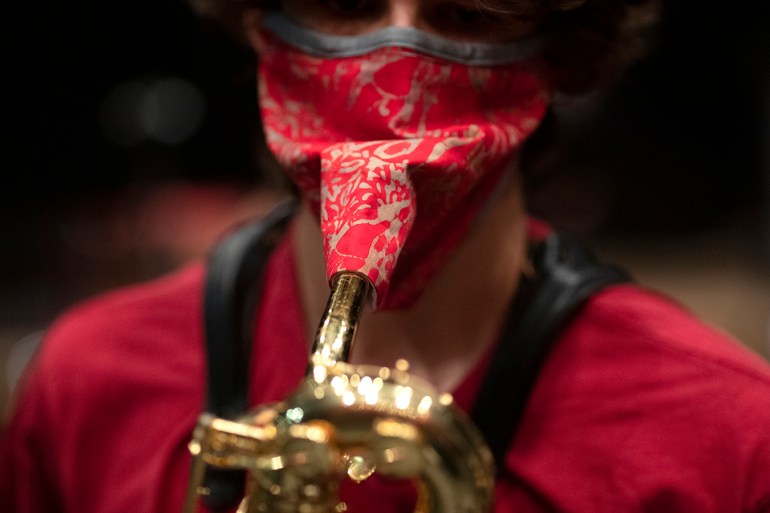
Solomon Keim rehearses in protective gear that doesn't mask the sound.(Chris Bergin for KHN)
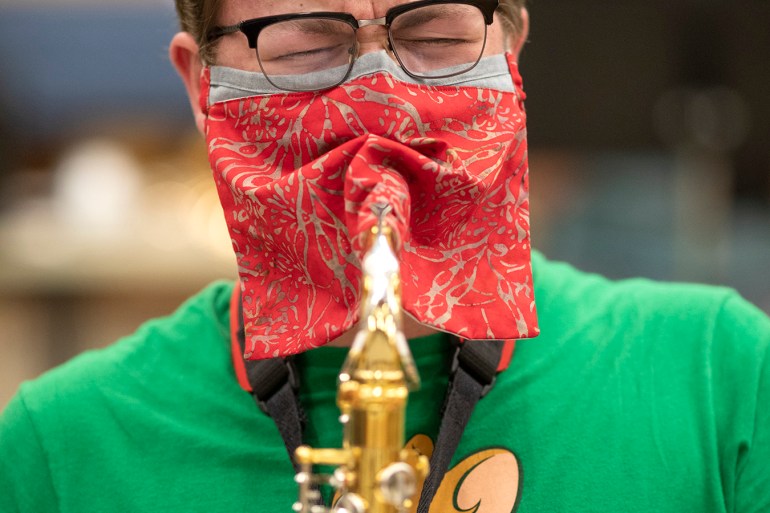
Brayden Wisley practices safe sax-playing. Other tips for musicians: Play in a big space with good ventilation, and break after 30 minutes to allow the air to clear.(Chris Bergin for KHN)
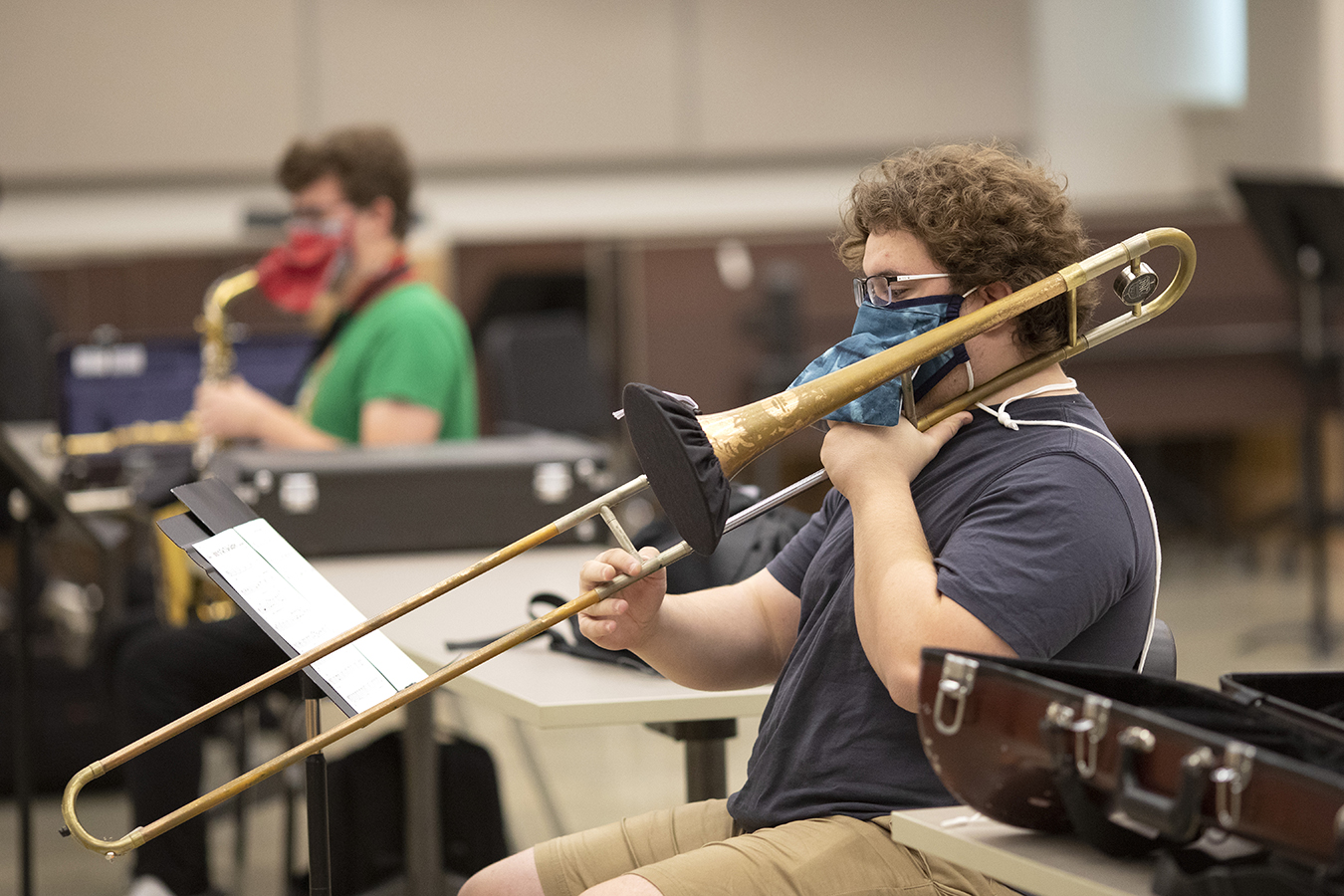
Brendan Sullivan plays trombone while both he and the instrument are masked. It has been recommended that most instrumentalists face the same direction while playing and stay 6 feet apart — with a distance of 9 feet in front and back of trombonists.(Chris Bergin for KHN)
A consortium of performing arts groups has commissioned research exploring ways for musicians to play safely. The group’s preliminary report from July recommends instrumentalists wear masks with small slits, use bell covers, face the same direction while playing and stay 6 feet apart for most instruments — with a distance of 9 feet in front and back of trombonists. Other research has shown cotton bell covers on brass instruments reduced airborne particles by an average of 79% compared with playing without one.
Jelena Srebric, a University of Maryland engineering researcher involved in the consortium’s study, said it’s also best to play in a big space with good ventilation, and musicians should break after 30 minutes to allow the air to clear. These rudimentary solutions, she said, promise at least some protection against the virus.
“Nothing is 100%. Being alive is a dangerous business,” Srebric said. This “gives some way to engage with music, which is fantastic in this day and age of despair.”
Dr. Adam Schwalje, a National Institutes of Health research fellow at the University of Iowa Hospitals and Clinics, is a bassoonist who has written about the COVID risk of wind instruments. He said a combination of bell covers, social distancing and limited time playing together could be helpful, but the effectiveness of bell covers or masks for musicians to wear while playing is “completely unproven” at this point. Schwalje’s paper said it’s not possible to quantify the risk of playing wind instruments, which involves deep breathing, sometimes forceful exhalation and possible aerosolizing of the mucus in the mouth and nose.
Still, early results of research at the universities of Maryland and Colorado are helping to inspire improvisational mask-making and other safety measures, said Mark Spede, national president of the College Band Directors National Association who is helping lead the commissioned research.
At Middle Tennessee State University, for example, tuba teacher Chris Combest said his students tie pillowcases over the bells of their instruments, and some wear masks that can be unbuttoned to play. At the University of Iowa, wind players in small ensembles must use bell covers and masks, but they can pull them down when playing as long as they pull them up during rests. Heather Ainsworth-Dobbins said her students at Southern Virginia University use surgical masks with slits cut in them and bell covers made of pantyhose and MERV-13 air filters, similar to what is used on a furnace.
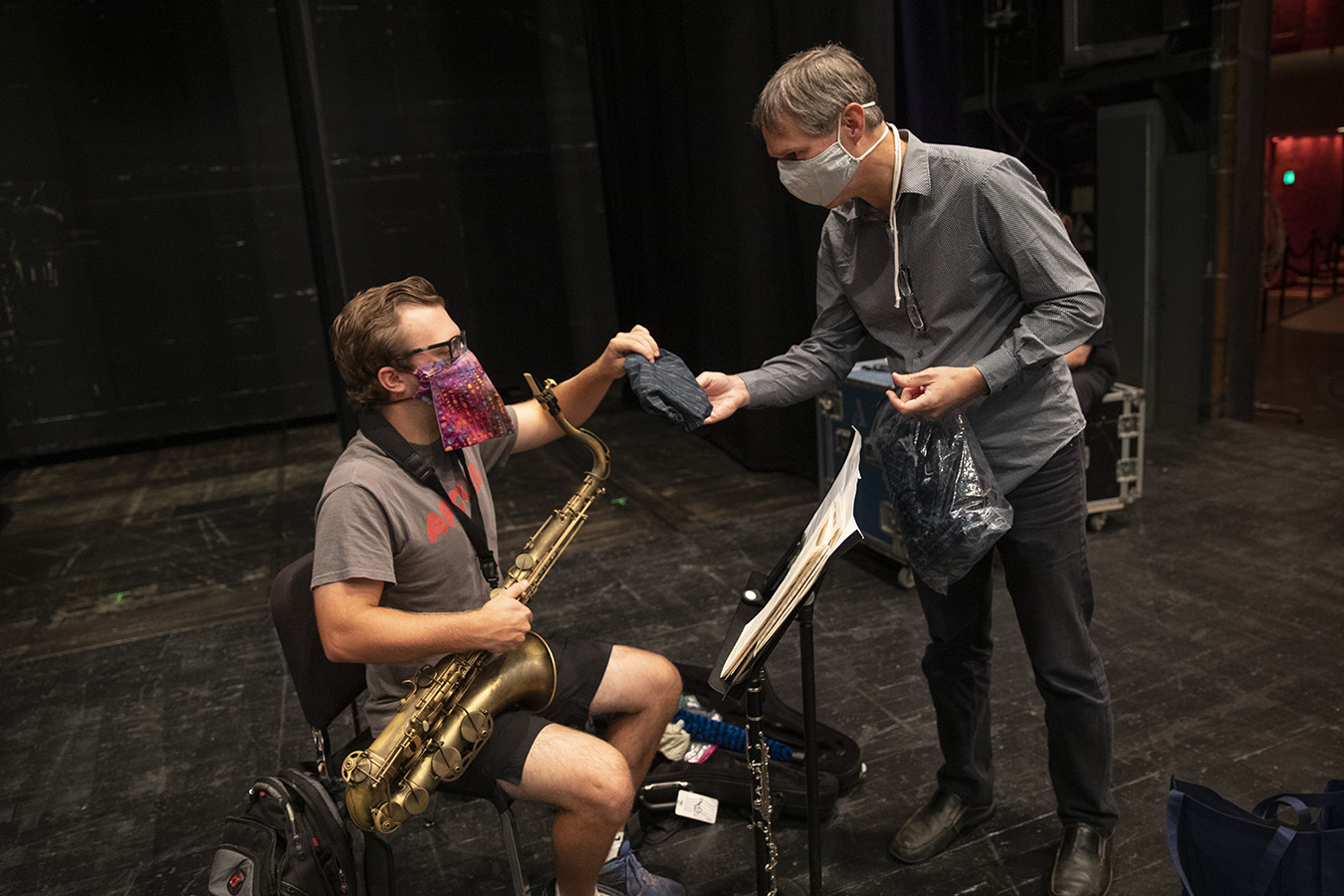
Indiana University Jacobs School of Music professor Tom Walsh distributes custom masks he designed that allow students to play their instruments safely as a group.(Chris Bergin for KHN)
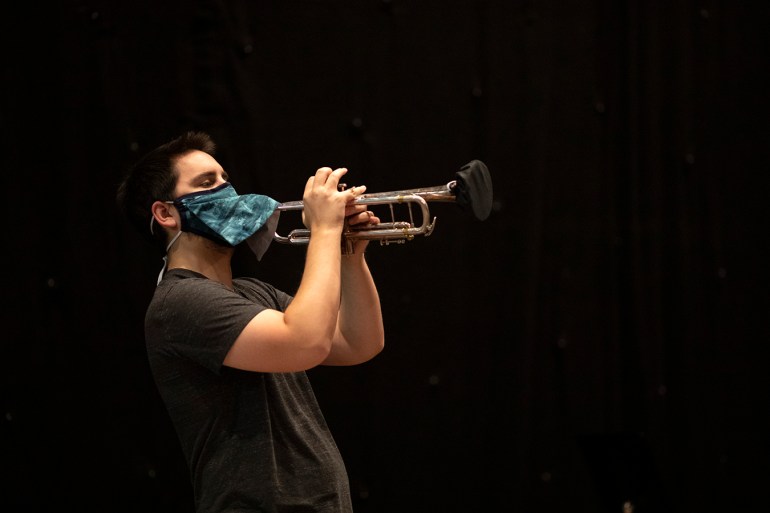
Skyler Floe tries out his horn's bell cover to much fanfare at Indiana University Jacobs School of Music in Bloomington, Indiana.(Chris Bergin for KHN)
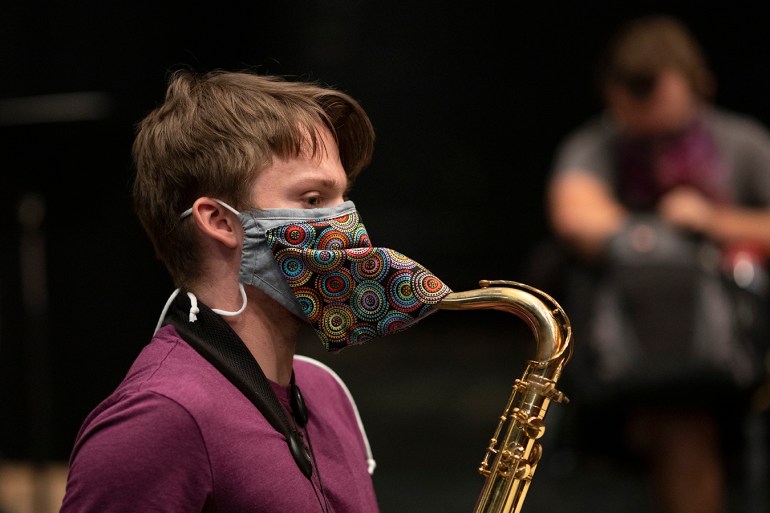
Kyle Cantrell's sound carries while reducing the risk of virus transmission.(Chris Bergin for KHN)
At Indiana, Walsh sought out whatever research he could find as he designed his tight-fitting cotton musical mask, reinforced with a layer of polypropylene and with adjustable ties in the back. A flap hangs over the hole, outfitted with two magnets that allow it to close over the instrument. The professor’s mom, Julie Walsh — who made his clothes when he was a kid — has sewn more than 80 of the musical masks for free. The opera program’s costume shop makes bell covers with a layer of fabric over a layer of stiff woven material known as interfacing fabric.
Bailey Cates, a freshman trumpet player, said the quality of the sound is about the same with these masks and they make her feel safer.
Flutes present unique challenges, partly because flutists blow air across the mouthpiece. Alice Dade, an associate professor of flute at the University of Missouri, said she and her students clip on device called “wind guards” usually used outdoors, then sometimes fit surgical masks over them.
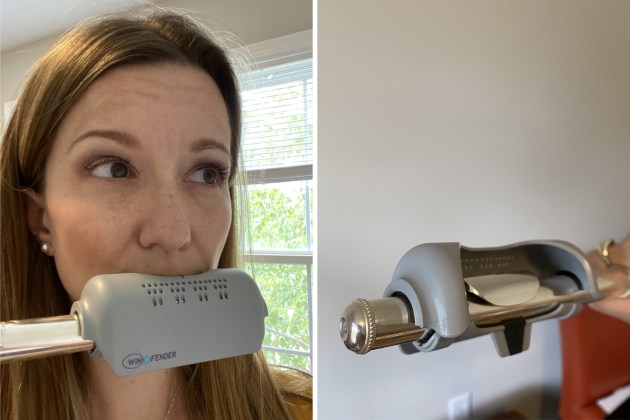
Alice Dade, an associate professor at the University of Missouri, recommends using clip-on devices for flutes called “wind guards,” which shield the lip plate of the flute from wind when playing outdoors. The ventilated design helps limit condensation and interference with the player’s air stream. Amid the pandemic, some flutists now use them with surgical masks on top to curb the spread of the coronavirus.(Alice Dade)
Indiana flute student Nathan Rakes uses a specially designed cloth mask with a slit and slips a silk sock on the instrument’s end. Rakes, a sophomore, said the fabric doesn’t affect the sound unless he’s playing a low B note, which he rarely plays.
Walsh is a stickler for finding big practice spaces, not playing together for more than half an hour and taking 20-minute breaks. All jazz ensemble musicians, for example, also must stay at least 10 feet apart.
“I carry a tape measure everywhere I go,” he said. “I feel responsible for our students.”
Some K-12 schools are trying similar strategies, said James Weaver, director of performing arts and sports for the National Federation of State High School Associations.
His son Cooper, a seventh grade sax player at Plainfield Community Middle School in Indiana, uses a surgical mask with a slit. It sometimes jerks to the side with the vibrations of playing, but Cooper said it “feels good as long as you have it in the right place.” Cooper also helped his dad make a bell cover with fabric and MERV-13 material.
While many groups use homemade bell covers, McCormick’s Group in Wheeling, Illinois, has transformed its 25-year-old business of making bell covers to display school colors and insignias into one that is making musicians safer with two-ply covers made of polyester/spandex fabric. CEO Alan Yefsky said his company started reinforcing the covers with the second layer this summer. Sales of the $20 covers have soared.
“It’s keeping people employed. We’re helping keep people safe,” Yefsky said. “All of a sudden, we got calls from nationally known symphony organizations.”
Other professional musicians take a different tack. Film and television soundtracks are often recorded in separate sessions; woodwinds and brass players in individual plexiglass cubicles and masked, with distanced string players recording elsewhere.
The U.S. Marine Band in Washington, D.C., practices in small, socially distanced groups, but string instrumentalists are the only ones wearing masks while playing.
For both professionals and students, the pandemic has virtually eliminated live audiences in favor of virtual performances. Many musicians say they miss traditional concerts but are not focusing on what they’ve lost.
“Creating that sense of community — an island to come together and play — is super important,” said Cates, the Indiana trumpet player. “Playing music feels like a mental release for a lot of us. When I’m playing, my mind is off of the pandemic.”
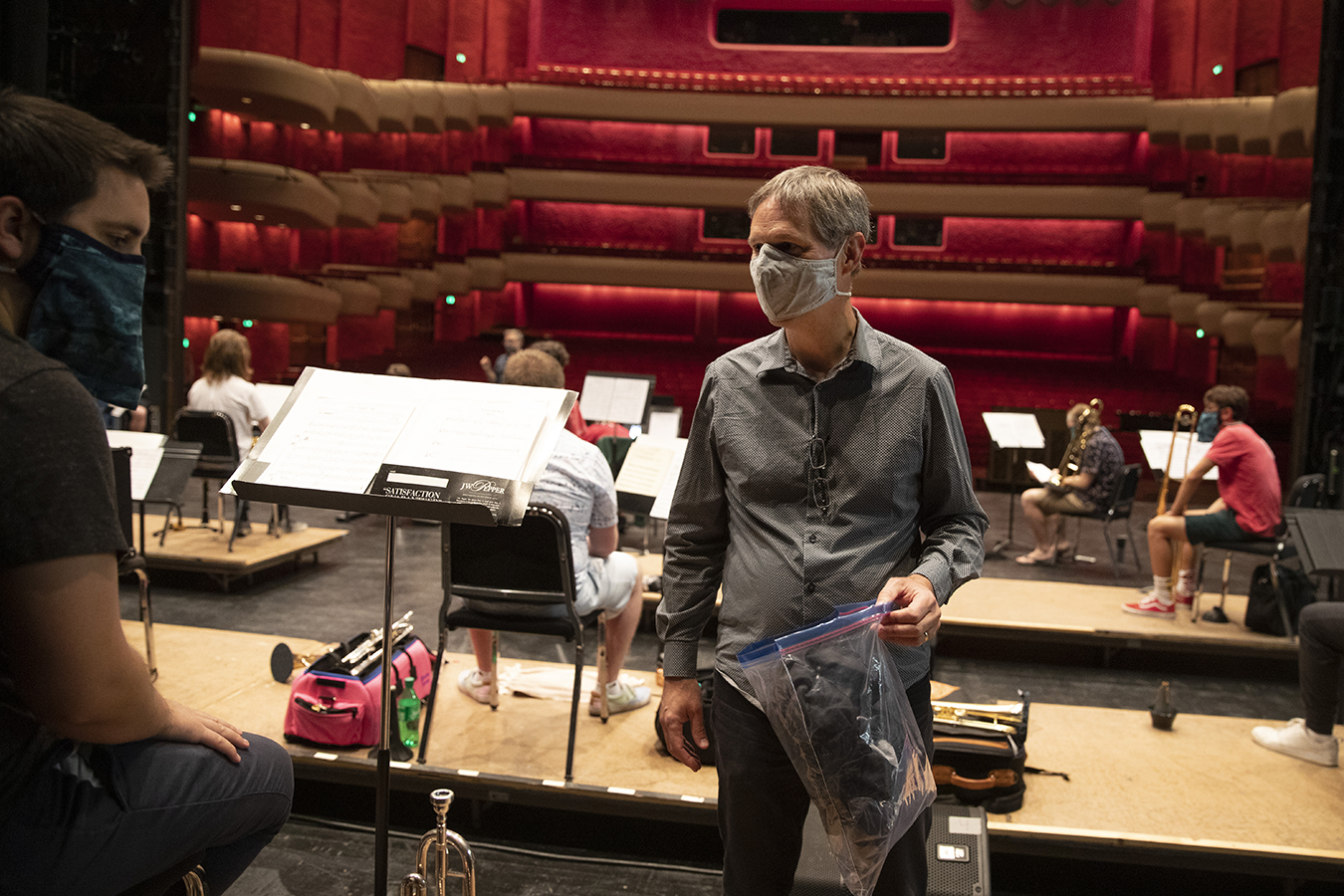
Indiana University Jacobs School of Music professor Tom Walsh works with students during rehearsal in Bloomington, Indiana. The professor’s mom, Julie Walsh — who made his clothes when he was a kid — has sewn more than 80 of the musical masks for free.(Chris Bergin for KHN)



